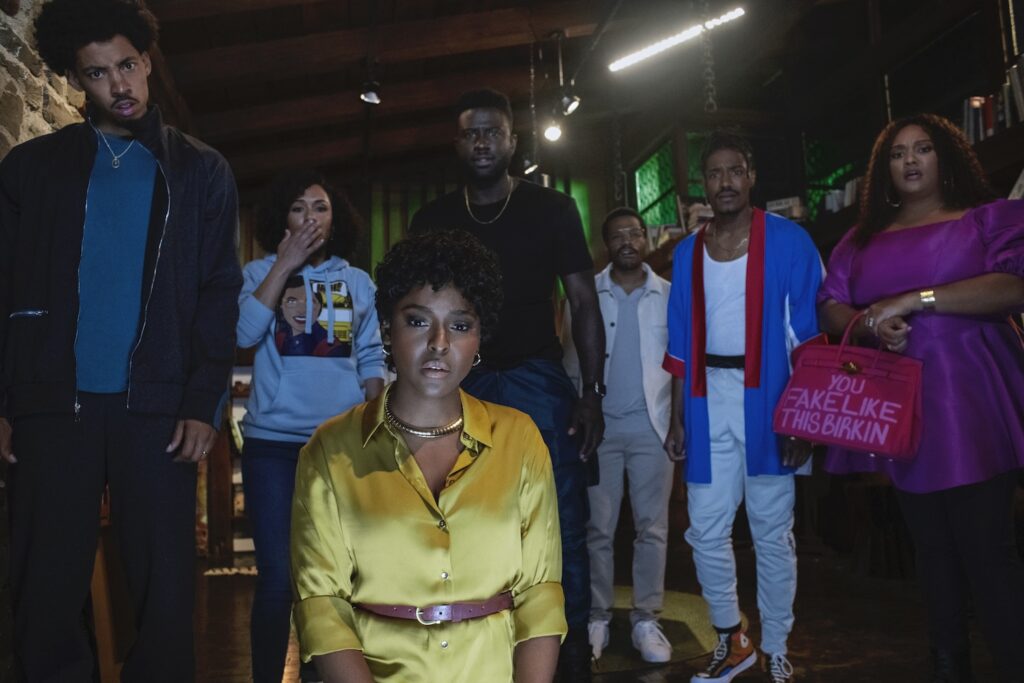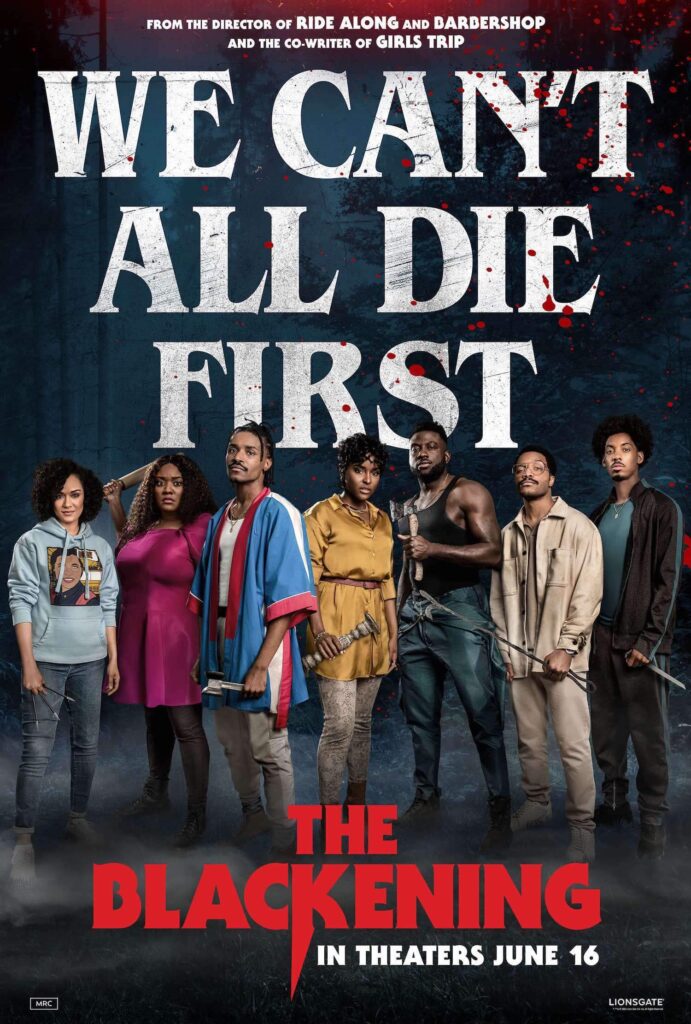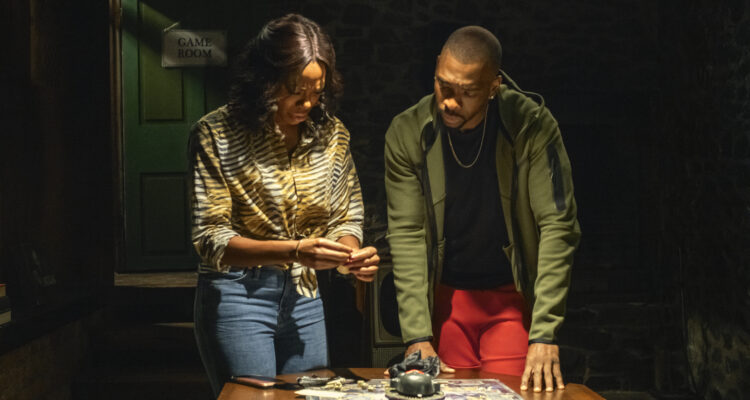Black characters in horror movies have a long history of getting screwed. They are disposable and often sacrificial. But this tired, predictable and probably racist cliche has been begging to be skewered for as long as knife-wielding maniacs have been killing teenagers.
Director Tim Story’s new film, The Blackening is a thumb in the eye of dumb horror movie cliches, in particular the ones about African Americans. Oh yeah, it’s also a sharp social satire of the divisions within American society and the stupid assumptions we make about each other. It’s funny, smart, surprising, scary and might be the most important horror comedy since Shaun of the Dead.
It’s not that you can’t enjoy The Blackening with a box of popcorn and your brain set to escapism mode. But the film is actually more than that.
“We always looked at it as satire,” Story says, over a Zoom call. “One of the things we wanted to be sure of with this film is that the stakes were real, and immerse it in a foundation of reality so that you can have all the fun on top of that.”
A group of friends meet for a Juneteenth weekend at a cabin in the woods. They quickly find themselves trapped in the cabin and forced to play by the rules of the killer using a game with a talking Black Sambo-esque caricature mocking them. The pop culture questions it asks are as much a litmus test for the audience as for the characters, who challenge each other on their qualifications to be part of a 21st Century black community, and spend much of their time looking for the outsider, the sell out. The interplay stirred by the game prods questions of identity and individuality within groups large and small. Even, in the films more meta moments, where or whether they belong in this horror film.

The hard questions about identity, society, and Hollywood are executed with a polished comic veneer that keeps the movie gliding along, never bogged down in self awareness.
“We never wanted it to be too goofy or too out there in terms of the humor,” Story says, “but we did know we were going to try to make something to made you laugh. And we wanted to be sure when the horror moments did show themselves, that you actually jump, that you actually felt like the characters were in real danger. That was something we worked on quite a bit.”
Part of the effectiveness of the film is the way it works within a familiar horror movie framework, then goes about constantly subverting expectations.
“That was extremely important,” Story says, crediting screen writers Tracy Oliver and Dewayne Perkins for keeping that goal in mind right from inception.
“Once you think we’re going in one direction, we wanted to surprise you wherever we could. It was always our plan to go against some of the stereotypes and to setup characters one way and peel back that layer of that character and show they’re more than you might think. The script was the foundation and then luckily I ended up with a cast that took it a step further and added some personal touches that made the characters really real. I felt like there was some three-dimensional things going on here with these characters.”
And the characters, (played with wit and charm by Grace Byers, Jermaine Fowler, Melvin Gregg, X Mayo, Perkins, Antoinette Robertson, Sinqua Walls, Jay Pharoah, and Yvonne Orji) show a knowing disregard for the genre, and ultimately reflect a larger sense of a world where reasonably intelligent people are stuck in an absurd and dangerous situation they might or might not have set themselves up for.
“That’s what Dwayne and Tracy achieved that was so brilliant. They wanted early on to not do anything that was considered dumb,” Story says.
“They wanted them to make choices that if you were in that situation, it may go that way. Obviously, it’s a movie, so sometimes we have to make some things go wrong and some of the decisions you think are the right decisions turn out to be not quite so right. But that was very important to us, that they be thinkers and not be dumb teenagers. We wanted our audience to be yelling at the scream — not ‘you dummy, don’t do that’ — to make it so that you would go along with their adventure because they’re not doing anything stupid. It just happens to be a situation that they’re gonna have to continue to deal with.”
Story took a lively mix of ad libs and a script packed with horror movie references, one liners and winks to the audience into the cutting room and found a whole new challenge: To sharpen the film even more.
“One of the cool things I started to see in the process of editing the movie, is we had so many gems, so many little magic moments, but there are times where I might allow some space so maybe you might hear this thing happening. We also got into the zone where if we made something that is just wall-to-wall value, you might have to see this movie a few times,” he says.
“You are going to miss some things because people are laughing or screaming at a certain thing and you didn’t hear the line. We heard quite often that people have to see it two and three times because they’re afraid they missed a joke and we often tell them they did,” he says, but he also had to find a balance.
“At some point, we stopped carving out so much space. We didn’t want any lulls in it. We also know at some point you’re going to be sitting at home watching this movie and we want you to have enough to watch there. As you’re in the theater, we just like the communal experience of people screaming and laughing and people going, ‘SHHHHH, I didn’t hear that.’”
But a scare-to-laugh ratio wasn’t in the plan, Story says, it was about what felt right for dark satire.
“We really walk that fine line, which for me is quite entertaining and I have a lot of fun with it. There’s so much love that’s been given to the script and the performances, we knew that if we want to try it and it made us laugh, cool. If it didn’t, we just won’t use it. But there weren’t a lot of limitations to going after what we wanted to try out,” he says.
Late in the movie, one of the characters shouts that the others “…haven’t fully grasped the gravity of the situation! …” seemingly cutting to the heart of what the film is about. It’s at this point Story says “the movie had to take on another level of intensity, for lack of a better word.” A moment Story says “really put a circle around what’s happening.”
The moment can strike different reactions depending on how you want to see the movie. For the popcorn movie viewer, it heightens the physical danger. For the viewer hooked in by the satire, it’s an acknowledgment of the societal danger played out the previous 90 minutes. And every day.
Regardless, the point is made. Our willingness to dispose of people endangers us all. And whether the monster wears a mask or not, it probably looks a lot like us.


